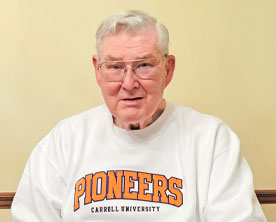
Menu

 |
In the early 1940s, when I was just a toddler, my father, Herman Welch, was in charge of the Carroll College physical plant. I have faint memories of him working out of an office in the basement of Rankin Hall. After graduating from Waukesha High School in 1957, my good friend Tom Rupers ’61, and I enrolled at Carroll. Money was short, but I could live at home.
Initially, I opted for a biology major, with Dr. Roy Christoph as my major professor. However, I discovered that the biology program had a pre-med orientation, and I was interested in natural history. Subsequent lectures in physical geography by Dr. Benjamin Richason changed my focus from biology to geography. I stayed with biology for four years but put my heart into geography, serving as a geography laboratory instructor in my junior and senior years.
At Carroll, track and cross-country coach Cliff Juedes and two close friends in the track program, Ken Ellsworth ’61 and Richard “Bud” Rumpf ’61, positively influenced my life. After graduating from Carroll in 1961, I spent a year at the University of Oklahoma pursuing an MA degree in geography. A summer working as an assistant on an Ohio State University Institute of Polar Studies project followed. I mapped glaciers and glacier landforms in southeast Alaska, the subject of my master's degree thesis.
My geography background at Carroll College and the University of Oklahoma led to employment with the CIA in the fall of 1962. The first days in the nation's capital were a bit scary due to the discovery of missiles in Cuba and the threat of war with the Soviet Union. My time at the CIA included a several-month assignment in Vietnam.
After returning to the U.S., I quit my job. I traveled to Scotland to pursue a Ph.D. at the University of Glasgow. My studies in photogrammetry, cartography, and glacial geomorphology involved two field seasons in Iceland, mapping changes to a large outlet glacier of the Vatnajokull ice cap. During my stay at Glasgow, I decided I would like to have an academic career but not until I had gained experience working in private industry and government. If I was going to teach, I wanted to be able to do so based on real-world experience outside of academia. While in Glasgow, I met my future wife, Jean McNeil, who, to borrow a phrase from the Kenny Rogers song, "decorated my life" for 51 years.
Back in the United States I accepted employment as manager of the Earth Science Department for Itek Corporation, followed by selection as a National Academy of Science, National Research Council, post-doctoral research associate with the U.S. Geological Survey's Topographic Research Center in McLean, Virginia. These experiences led me to accept a geography professorship at the University of Georgia. With my previous background I rose quickly through the academic ranks, eventually being appointed as a distinguished research professor and establishing a research unit—the Center for Remote Sensing and Mapping Science (CRMS). In 1975 Carroll College selected me for a Distinguished Alumnus Award.
Most of my teaching was to senior-level undergraduate and graduate students. I believed in making classwork in remote sensing, photogrammetry, and geographic information system (GIS) courses challenging and up to date. I always encouraged students to participate in CRMS research projects.
In my experience, research projects provide significant value to college students. External funding can support students, purchase relevant hardware/software, and cover project travel expenses. Most important, from the student's standpoint, is the opportunity to gain practical learning experience on projects, such as the Carroll University North Lake Project, that require using a variety of cutting-edge techniques for the acquisition and analysis of data.
A valuable part of the learning experience involves overcoming challenges not encountered in a textbook environment. In addition, a student has an opportunity to work with experts and, hopefully, gain an increased appreciation for the value of their academic classroom experience. They should be required to prepare reports, either individually or in concert with their professor, gaining skill in the clarity and conciseness of written expression.
In addition to the benefits to students, research projects generate funds for the university. They provide the opportunity for increased exposure through publications, professional meetings, and expanded contacts—all catalysts for enhancing the institution's reputation and its faculty.
In summary, my four years at Carroll College provided a foundation for a successful career encompassing government, private industry, and academia. I hope establishing a faculty position in the new Aviation Science Program will help others to benefit from a Carroll University education.
—Roy Welch ’61
Support your passion at Carroll University
Give passionately and wisely with our collection of tools and information:
Learn more about making an IRA Rollover gift here.
Ready to make an IRA Rollover gift? use our tool here: carrollu.edu/ira
Add Carroll to your will.
Make Carroll the beneficiary of your retirement plan.
Join the 1846 Legacy Society.
© Pentera, Inc. Planned giving content. All rights reserved.
Disclaimer
